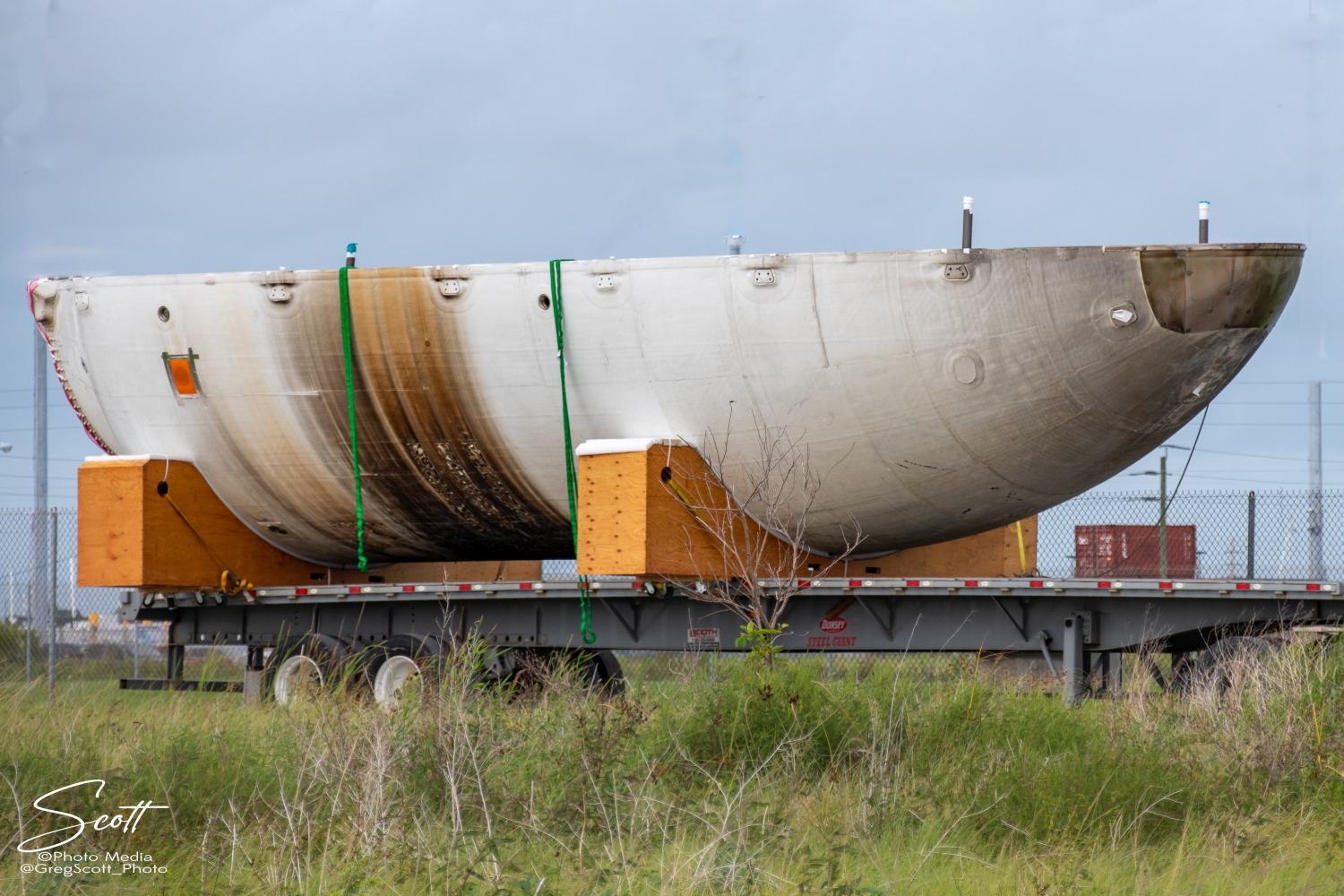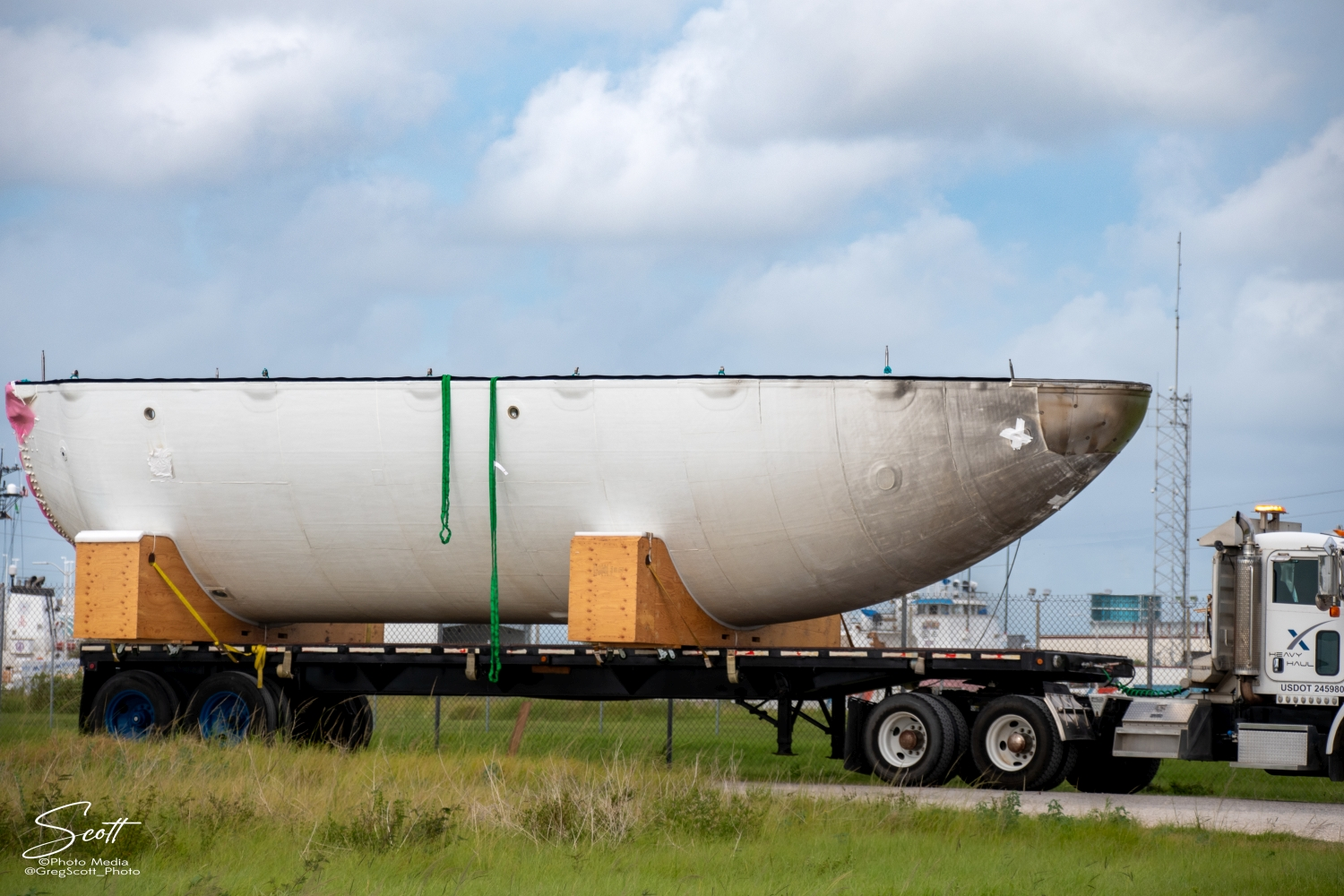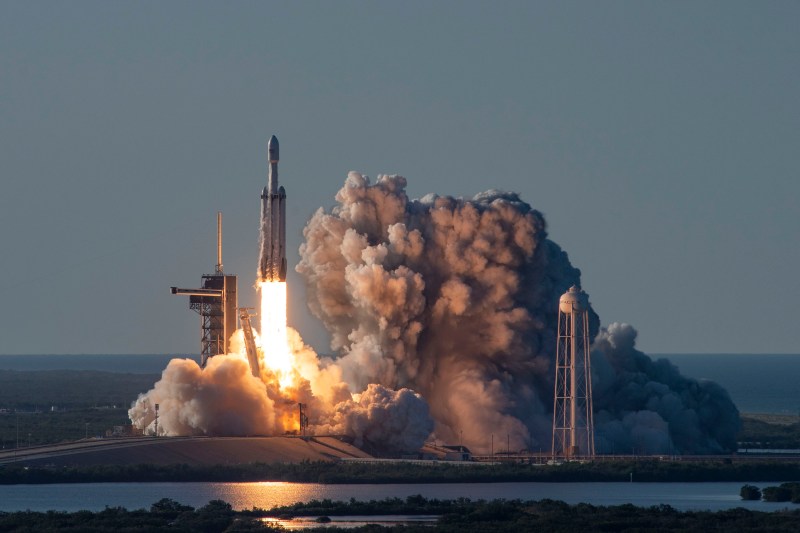Featured image credit: SpaceX
Launch Window | November 01, 2022 – 13:41 – 14:11 UTC | 09:41 – 10:11 EDT |
|---|---|
Mission Name | USSF-44 |
Launch Provider | SpaceX |
Customer | United States Space Force (USSF) |
Rocket | Falcon Heavy, B1064-1, B1065-1, B1066-1 |
Launch Location | Launch Complex 39A (LC-39A), Kennedy Space Center, Florida, USA |
Payload mass | Unknown |
Where are the satellites going? | GEO, the exact longitude is unknown |
Will they be attempting to recover the first stage? | Yes (side boosters) and no (center core) |
Where will the first stage land? | The two side boosters will land at Landing Zone 1 and Landing Zone 2 |
Will they be attempting to recover the fairings? | The fairing halves will be recovered from the water by recovery ship Doug. |
Are these fairings new? | Yes |
How’s the weather looking? | The weather is currently 90% go for launch. (as of October 31, 2022 – 13:00 UTC) |
This will be the: | – 4th Falcon Heavy launch – 1st flight for B1064, B1065, B1066 – 150th and 151st booster landing if successful – 76th and 77th consecutive landing (a record) – 193rd overall SpaceX mission – 50th launch for SpaceX in 2022 (a record) – 56th SpaceX launch from LC-39A – 149th orbital launch attempt of 2022 |
Where to watch | Official livestream Tim Dodd, the Everyday Astronaut, will be streaming at around T-90 minutes; come ask questions and join the conversation live! |
What Does All This Mean?
USSF-44 is classified mission for the United States Space Force lifting off from Launch Complex 39A at the Kennedy Space Center in Florida, USA. USSF-44 will be inserted directly into a GEO by SpaceX’s Falcon Heavy, which will fly for the fourth time in total and the first time this year.
USSF-44 Mission
While the exact payload manifest for this launch is unclear, USSF-44 contains six payloads that will be directly inserted into a geostationary orbit (GEO). The main payload, USSF-44, is most likely a military communications satellite, which is classified with no information on it available. It is unclear though at what longitude it will be inserted. The other payloads are CubeSats and small satellites that hitch a ride to GEO and will be deployed by Northrop Grumman’s Long Duration Propulsive ESPA, or short LDPE.
- USSF-44
- LINUSS-A 1 and LINUSS-A 2
- USUVL (not confirmed)
- TETRA-1
- WL2XOU (not confirmed)
Long Duration Propulsive ESPA
The LDPE (Long Duration Propulsive ESPA; ESPA = EELV Secondary Payload Adapter; EELV = Evolved Expendable Launch Vehicle) is serving as the ride share payload on the USSF-44 mission. The ESPA is simply a payload adapter used to help attach the LDPE to the main satellite in addition to hosting a few slots for other smallsats. However, the entire system is powered by the ESPAStar satellite bus, which is in charge of power consumption and distribution as well as propulsion. ESPAStar has the capability to host 6 smallsat payloads totaling 1,920 kg (4,230 lb). The system is also able to provide 400 meters per second of delta-V via a Hydrazine propulsion module.

LINUSS-A 1 & LINUSS-A 2
LINUSS stands for Lockheed Martin’s In-space Upgrade Satellite System and LINUSS-A 1 & LINUSS-A 2 are a pair of LM50TM 12 U CubeSats. With two deployable solar arrays, LINUSS-A 1 and A 2 are designed to operate in geostationary, geosynchronous or similar orbits to test, advance, and validate technologies that are not ready to be placed on bigger geostationary payloads.
Both LINUSS CubeSats are also testbeds for Lockheed Martin’s LM 2100TM satellite bus platforms, aiming to validate various systems:
- essential maneuvering capabilities
- on-board high performance processing by Innoflight
- low-toxicity propulsion by VACCO
- IMUs, machine vision, 3D printed components, and SmartSatTM technologies by Lockheed Martin

USUVL & WL2XOU
There’s practically no information on either USUVL and WL2XOU. Both satellites are believed to be CubeSats or small test satellites for use in geostationary and/or in a 2.8° inclined super synchronous orbit to minimize potential interference with other GEO spacecrafts.
TETRA-1
TETRA-1 is another test satellite for in and around GEO. The microsatellite was built by Millenium Space Systems (a Boeing company) for the United States Space Force, and is the first of four TETRA satellites built by three different companies. TETRA-1 will test on-orbit maneuverability, as well as offer a training scenario for both new and experienced satellite operators.

What Is Falcon Heavy?
The Falcon Heavy is SpaceX’s partially reusable two-stage heavy-lift launch vehicle. The vehicle consists of two reusable side boosters, a reusable center core, an expendable second stage, and a pair of reusable fairing halves.
First Stage
The Falcon Heavy first stage contains 27 Merlin 1D+ sea level engines. Each booster contains nine engines. Each engine uses an open gas generator cycle and runs on RP-1 and liquid oxygen (LOx). Each engine produces 845 kN of thrust at sea level, with a specific impulse (ISP) of 285 seconds, and 934 kN in a vacuum with an ISP of 313 seconds. Compared to a normal Falcon 9 Block 5, Falcon Heavy’s first stage consists of two side boosters and a center core, with the side boosters basically being Falcon 9 boosters with a nose cone on top instead of an interstage. The center core on the other hand is a more modified booster equipped with a booster separation system and modified to handle the increased loads of three boosters.
The Merlin engines are ignited by triethylaluminum and triethylborane (TEA-TEB), which instantaneously burst into flames when mixed in the presence of oxygen. During static fire and launch the TEA-TEB is provided by the ground service equipment. However, as the Falcon Heavy first stage is able to propulsively land, three of the Merlin engines (E1, E5, and E9) contain TEA-TEB canisters to relight for the boost back, reentry, and landing burns.
Second Stage
The Falcon Heavy second stage is the same as a Falcon 9 one. It contains a singular MVacD engine that produces 992 kN of thrust and an ISP of 348 seconds. The second stage is capable of doing several burns, allowing the Falcon Heavy to put payloads in several different orbits.
On this missions, the second stage is equipped with the MEK (mission extension kit) that allows it to support missions with many burns and/or long coasts between burns. This package can have a gray strip, which helps keep the RP-1 warm, an increased number of composite-overwrapped pressure vessels (COPVs) for pressurization control, and additional TEA-TEB for multiple re-lights of the MVacD engine.

Falcon Heavy Boosters
The boosters supporting the USSF-44 mission are B1064, B1065, and B1066, which have not supported any other missions yet. Hence, its designation for this mission is B1064-1, B1065-1, and B1066-1; this will change to 1064-2, and 1065-2 upon successful landing. The center core, B1066-1, will not be recovered.
| B1064’s missions | Launch Date (UTC) | Turnaround Time (Days) |
| USSF-44 | October 31, 2022 – 14:44 | N/A |
| B1065’s missions | Launch Date (UTC) | Turnaround Time (Days) |
| USSF-44 | October 31, 2022 – 14:44 | N/A |
Following booster separation, the Falcon Heavy boosters will conduct three burns. These burns aim to softly touch down the boosters on SpaceX’s Landing Zone 1 and Landing Zone 2.

Falcon Heavy Fairings
The Falcon Heavy’s fairing consists of two dissimilar reusable halves. The first half (the half that faces away from the transport erector) is called the active half, and houses the pneumatics for the separation system. The other fairing half is called the passive half. As the name implies, this half plays a purely passive role in the fairing separation process, as it relies on the pneumatics from the active half.
Both fairing halves are equipped with cold gas thrusters and a parafoil which are used to softly touch down the fairing half in the ocean. SpaceX used to attempt to catch the fairing halves, however, at the end of 2020 this program was canceled due to safety risks and a low success rate. On USSF-44, SpaceX will attempt to recover the fairing halves from the water with their recovery vessel Doug.
In 2021, SpaceX started flying a new version of the Falcon fairing. The new “upgraded” version has vents only at the top of each fairing half, by the gap between the halves, whereas the old version had vents placed spread equidistantly around the base of the fairing. Moving the vents decreases the chance of water getting into the fairing, making the chance of a successful scoop significantly higher.


USSF-44 Countdown
All times are approximate
| HR/MIN/SEC | EVENT |
|---|---|
| 00:53:00 | SpaceX Launch Director verifies go for propellant load |
| 00:50:00 | RP-1 (rocket grade kerosene) loading underway |
| 00:45:00 | 1st stage and side booster LOX (liquid oxygen) loading underway |
| 00:35:00 | 2nd stage RP-1 loading underway |
| 00:18:30 | 2nd stage LOX loading underway |
| 00:07:00 | Falcon Heavy begins engine chill prior to launch |
| 00:00:59 | Command flight computer to begin final prelaunch checks |
| 00:00:45 | SpaceX Launch Director verifies go for launch |
| 00:00:20 | Propellant tank pressurization to flight pressure |
| 00:00:06 | Engine controller commands engine ignition sequence to start |
| 00:00:00 | Falcon Heavy liftoff |
USSF-44 Launch, And Landing
All times are approximate
| HR/MIN/SEC | EVENT |
|---|---|
| 00:01:11 | Max Q (moment of peak mechanical stress on the rocket) |
| 00:02:24 | Side boosters engine cutoff (BECO) |
| 00:02:28 | Side boosters separate |
| 00:02:45 | Side boosters boostback burns start |
| 00:03:53 | Side boosters boostback burn ends |
| 00:03:54 | 1st stage main engine cutoff (MECO) |
| 00:03:58 | Center core 1st and 2nd stages separate |
| 00:04:04 | 2nd stage engine starts |
| 00:04:18 | Fairing deployment |
| 00:06:48 | Side boosters entry burn start |
| 00:07:03 | Side boosters entry burn complete |
| 00:08:00 | Side boosters landing burn start |
| 00:08:11 | Side boosters landing |






Light rhat firecracker!!!🧨🧨🧨🧨
What happens to the center booster that’s not recovered, does it fall back to earth?
Yes. It will land in the ocean. My guess is they’ll expend all it’s fuel, so it wouldn’t have enough for a reentry burn, and will probably break up in the atmosphere. It’s probably lacking the grid fins and cold gas thrusters to reorient itself, so it will probably break up high in the atmosphere, and the debris will land in the ocean.
Perhaps I found a typo, under the fairing section, it says:
“On Starlink Group 4-31, SpaceX will attempt to recover the fairing halves from the water with their recovery vessel Doug.”
Shouldn’t that say “USSF-44”?
Also, do we know why they’re not attempting to recover the center core? Do we think the payload mass is too heavy?
Spaceflight now has the launch date of Nov 1, 1340 GMT, whereas you show it as October 31, 2022 – 14:44 UTC (which would have been in the past)
Thank you, Florian and Trevor for your informative article. Could you post the USSF-44 mission insignia’s similar to the CRS-25 mission insignia’s?
According to Wikipedia, The Falcon Heavy can also inject a 16 t (35,000 lb) payload into GTO if only the two side boosters are recovered. Then why payload for this mission is only 3,750 kg (8,270 lb) (according to Wikipedia again)?
This is not GTO launch it’s literally right here on this page! Direct to GEO! 🤷🏻♀️
Okay: Did the launch put the payload directly in a parking orbit inclined 0 degrees to the equator, or is the second stage burn going to involve a large plane change?